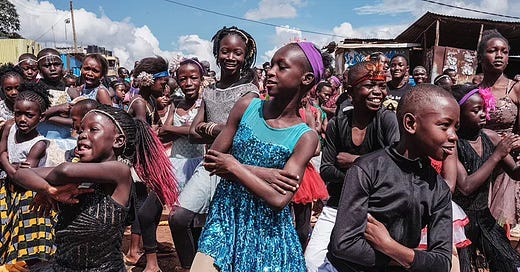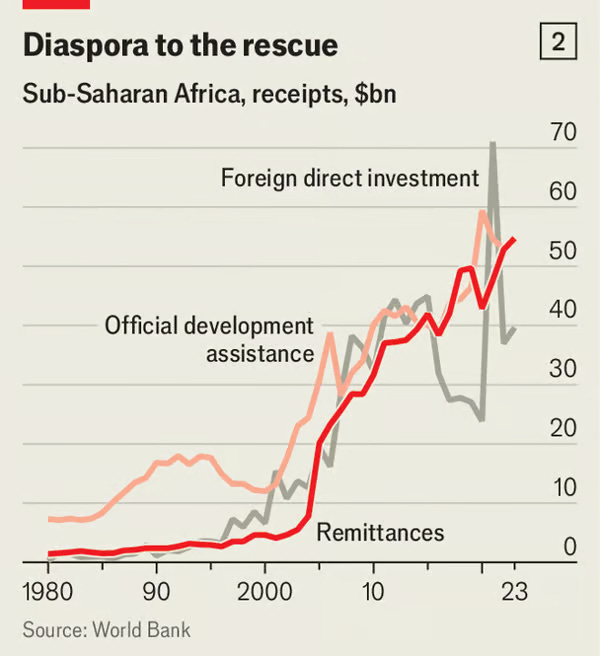This is a reader-supported publication. I give it all away for free but could really use your support if you want me to keep doing this.
Continuing from yesterday, the chart above is The Economist’s version of the McKinsey Global Institute chart entitled “Working Age Populations Peak in Three Waves,” as found in their recent report.
The first wave crew is described as basically the old West plus China, the second wave cohort are the emerging economies of our age, and the third wave is Sub-Saharan Africa all by itself.
Yesterday, I noted how this waves chart and its logic FINALLY validated my own calculations based on the demographic estimates of Neil Howe and Richard Jackson in their 2008 book entitled "The Greying of Great Powers.”
My version of the three-wave slide by McKinsey is familiar to you all.
This is the McKinsey chart that really jumps out at you:
Yesterday, I said I doubted that projection of one-out-of-every-three humans on the planet hailing from Sub-Saharan Africa in 2100 and would explain my reasoning today.
Here’s the simplest explanation:
Almost all of Africa is located in my Middle Earth designation of 30 degrees north and south of the equator, or where climate change will most devastate the landscape.
Here’s another:
Africa is water-insecure, which means …
Africa is food insecure — as in, it can barely feed itself in the sub-Saharan and is entirely import-dependent in the Arab north.
A water-insecure Africa that cannot — or can only barely — feed itself today is going to have a far harder time growing food and feeding itself across the rest of this century if the Sub-Saharan portion of the continent is systematically exposed to weather, temperature ranges, and precipitation amounts historically associated with that of the neighboring Saharan Desert — namely, close to 90 degrees Fahrenheit daily average, drought as the norm, and chaotic flooding when rain does come.
In short, if you subject Sub-Saharan Africa to the same climate as Saharan Africa, then we’re talking some fantastic stress on those countries presently experiencing rapid population growth this century.
History says, people will leave — in vast numbers.
And that’s what this excellent Economist report is all about: a future world defined by a magnificent outflow of African workers to the rest of the global economy — not just because of environmental stress and population pressures but because a rising African economy will naturally shed excess workers, like Europe did in the 19th century and like rising economic powers do today.
People leave when times are bad but they also leave when times are good because, in both instances, the amount of opportunity is overwhelmed by the population numbers.
The big point here, in my mind: all this fear in the North about not having enough babies or workers or demographic collapse this century is deeply misplaced — UNLESS you’re firmly against south-to-north migration and the idea of accepting large numbers of Africans into your economy and culture.
The demographic challenge and problems we face in the North are real, but they’re also eminently solvable.
First off, I am not an expert on Africa, but I’ve been writing about it for … really … good God! … four decades (since 1985 and my dissertation, which had a high African quotient). I also worked with USAID’s Africa Bureau for a couple of years in the late 1990s. I’ve also been to Africa six times, traveling to, and working in, South Africa, Senegal, Morocco, Egypt, Djibouti, Ethiopia, and Kenya, with one of those trips seeing me embedded as a journalist with US Army National Guard and Special Operations personnel. So, not truly an expert but plenty of exposure over the years.
Turning now to The Economist:
The vast majority of Africans leave the continent in prosaic, legal ways. This form of migration has continued to increase despite the rise of anti-immigrant sentiment. It will in all likelihood continue to grow in the coming decades, expanding African diasporas around the world. The trend will have profound effects in recipient countries and in Africa itself.
Important point to remember in an age when we’re told that virtually all migrants are illegal.
Demographics drives all:
The growth stems from the extraordinary demographic divergence between Africa, the world’s youngest continent with the fastest-growing population, and everywhere else. Labour is becoming more abundant in Africa and scarcer in many other places. As a result, argue Kathryn Foster and Matthew Hall, demographers at Cornell University, “The future of migration will be African in origin.”
For once, Africa being “behind” works to its advantage — assuming AI and climate change don’t sabotage all that:
The region is decades behind in its “demographic transition”. Its working-age population will rise by around 700m by 2050, roughly doubling. By 2030 roughly half of new workers entering the global labour force will be from sub-Saharan Africa
Here are the type of numbers driving so many Indians abroad despite the high growth rate there: 15m African workers enter the market every year across Sub-Saharan Africa, which annually generates only 3m new formal jobs (non-black market/informal). That’s 12m a year added to the formally unemployed category.
Africans can take a hint:
A survey last year by Afrobarometer, a pollster, found that 47% of Africans in 24 countries had considered migrating and 27% had given it “a lot of thought”—increases of nine and ten percentage points respectively since the previous round of surveys in 2016-18. “Better work opportunities” was by far the most cited reason.
This is an entirely normal pattern through which numerous countries have arisen:
The tendency to migrate from a given country follows a pattern that, when drawn on a chart against gdp per person (adjusted for the cost of living), forms a bell curve. Emigration rises as countries approach around $5,000 in income per person, peaks at around $10,000 and declines thereafter. In poor countries people lack the resources to leave. In rich ones they lack the need. In middling places they have both the will and the wherewithal.
Mexico is past its peak, as was Puerto Rico long before it. If you want to stem immigration from poor countries, then help them develop. It’s as easy as that.
Africans’ share of the global emigre population is ticking up: now at 15% versus 13% at Cold War’s end. But don’t let those numbers fool you:
Back then, 35% of migrants from Africa lived outside the continent, rather than in another African country. Today the share is 45%. That amounts to 20.7m people, triple the figure in 1990 and more than the number of Indians living outside India (18.5m) or of Chinese outside China (11.7m).
Roughly half of Africans settle in Europe, as a rule, and Europe is aging fast.
Used to be no Africans came to the US (1% of inbound in 1960). Now, it’s up to 11% and your average American interacts with native Africans on a regular basis. I know I do, and I’m not just talking my two youngest kids — both immigrants themselves! Africans are everywhere nowadays.
Check out these stunning figures:
Net migration [to the US] from the Caribbean and Africa in the 2010s was twice as high as from Latin America. Four times more Africans arrived in America between 1990 and 2020 than during the slave trade, estimates Neeraj Kaushal of Columbia University.
If that doesn’t surprise you, then nothing will.
The trick for African immigrants? Finding out they’re Black in America, whereas, back home, they belong to tribes and, to a lesser degree, nations, so skin color really isn’t a factor in their identity.
For the longest time, the most frequently-met African immigrant was a professional, like a doctor. But more and more are coming over and filling in your more average jobs, with the biggest challenge being acculturation to American society.
Last weekend, I edited a PhD dissertation for an African immigrant getting her doctorate in public health. Even with English being her eighth language (after Chinese and Japanese and a bunch of African dialects), my grammar edit was light and I spent almost all my time formatting. Her subject? The challenges African immigrants face in accessing US healthcare — a subject that can only grow in importance for all of us Americans.
One big bright spot as USAID is shuttered by the Trump administration: the more African immigrants we accept, the greater the flow of remittances back to Africa — increasingly surpassing what is/was our aid flow. It also goes hand in hand with foreign direct investment — the best money flow.
Still, America abandoning Africa as an aid recipient will be a crushing blow to many African economies. If we’re not going to have foreign aid anymore, then we better start some sovereign wealth funds to fill that gap. For example, China’s Belt and Road Initiative (BRI) is not itself a sovereign wealth fund but relies heavily on Chinese sovereign funds and state-owned financial institutions for financing and implementation. Maybe that’s the future of US foreign aid?
Something to ponder.
The piece ends:
Africans need jobs; the rest of the world needs workers. That confluence of interests is a massive opportunity, if only both sides have the good sense to seize it.
As always, a great piece from The Economist.














